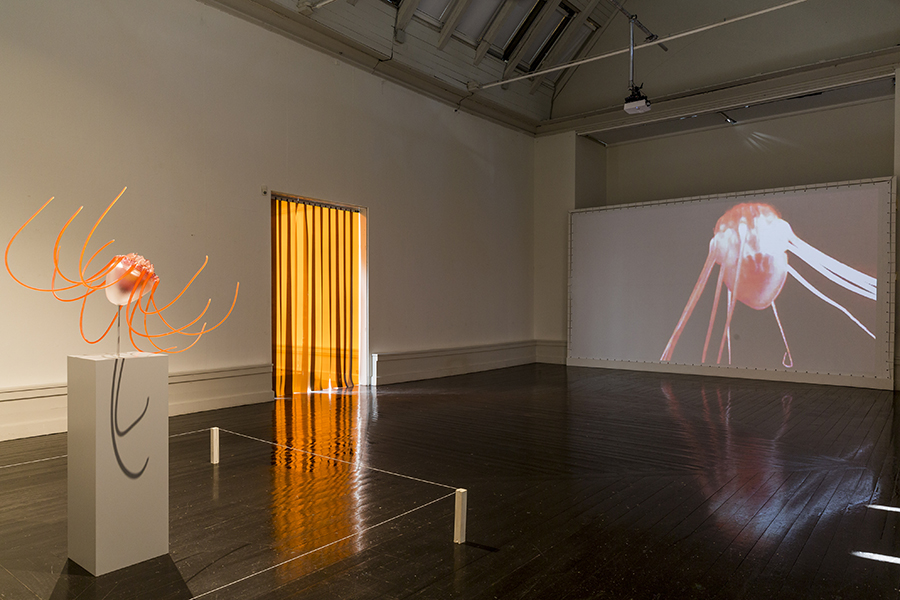Tue Greenfort
Den Frie, Copenhagen, Denmark
Den Frie, Copenhagen, Denmark

The first thing you notice in the exhibition ‘Tue Greenfort Eats Den Frie’ is a monotonous electronic sound, akin to the white noise of an old TV. Then comes the harsh smell of old soil and dust, as the senses are set on high alert. The soundtrack, which was composed in collaboration with the Copenhagen-based Hari Shankar Kishore, bleeds in various permutations throughout Den Frie, providing an aural backdrop for an exhibition of living organisms flourishing amidst a synthetic landscape.

At the moment, plants, flowers and gardens are strewn throughout the landscape of Danish contemporary art, as the recent ARoS Triennial in Aarhus, titled ‘The Garden’, made clear. Now, more than ever, the hype is highly relevant. As Donald Trump stands by his decision to pull the US from the Paris climate agreement, I cannot think of a subject that is more acute than the current catastrophic state of the ecosystem. Greenfort’s interest in this topic is long-standing. As part of the 2007 edition of Skulptur Projekte Münster, for instance, he parked a large manure truck, titled Diffuse Einträge (Diffuse Entries, 2007), on the bank of Lake Aasee. The work was made in response to pollution problems specific to Münster, but its eco-philosophy can be applied to any terrain in which the landscape has been transformed by monocultural agriculture through the use of fertilizers that pollute ground water and pesticides that endanger bees.

Several works at Den Frie convey messages that are equally universal. The exhibition starts in a dusky room, at the end of which a slow video projection, also made in collaboration with Shankar Kishore, follows one of the oceans’ most viable creatures: the Periphylla periphylla jellyfish (also the work’s title), which is said to have existed, in various mutations, for over 700 million years. Set against this impressive life span, Homo sapiens, at a meagre 500,000 years old, appears rather young, and it is this relationship between fledgling humankind and more established forms of animal- and plant-life that is explored throughout this exhibition – the post-human development of a pre-human ecosystem.
The darkness of this first room opens onto Ruderat (Wasteland, 2017), a transitional no man’s land of earth, weed, garbage, old tires and other detritus, backed by a part of the sound work that is reminiscent of a swarm of locusts. Make your way through this artificial landscape to the next space, and you will find a large-scale fountain made of chipboard. Titled UREA (2017), and mirroring the octagonal form of Den Frie, the structure has been coated with crystallized urine extract. Normally, this substance is employed as a fertilizer (Struvite); here, however, it slowly breaks down the chipboard, transforming it into a new, drooping form, layered with crystalline clumps resembling those of a cauliflower.

Through a room of mounted newspaper clippings relating to climate change, and a somewhat sparse zone centred upon two hanging rope-sculptures, is a field sown with rapeseed: Monoculture (2017), which occupies the entirety of the show’s final room, its walls covered in mirrors to give the impression of vastness. At the opening of the exhibition, the freshly sown field promised much; at the time of writing, however, it hasn’t flourished. Instead, it looks rather exhausted, the crops flaccid, withered, with thin stems. This work, and the exhibition as a whole, represents a kind of experiment, in which organic processes are allowed to grow and develop arbitrarily – for better or for worse. This chance element, twinned with Greenfort’s talent for transforming highly acute ecological problems into sensuous installations, have a positive impact on the show. But it could be argued that the exhibition presents too many different environments within too restricted a space – something that denies the viewer access to those prolonged periods of contemplation that these large, pressing ecological questions demand.
Main image: Tue Greenfort, 'Tue Greenfort Eats den Frie', 2017, installation view, Den Frie, Copenhagen. Courtesy: Den Frie, Copenhagen























